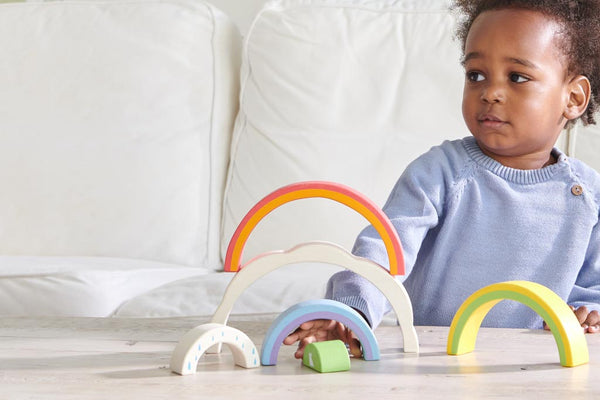Seriation: the art of ordering

Before your child’s first maths lesson at school, she will have already begun developing vital skills that form the foundation of her mathematical understanding. One of these skills is seriation, the ability to arrange objects in a specific order based on a particular attribute, such as size, shape, or colour.
In this way, she learns to compare, think logically and problem solve.
That’s a lot of maths from one simple idea! Let’s take a more detailed look.

How seriation supports mathematical concepts
Much of school-level maths is about spotting patterns and making sense of numbers in context.
1, 2, 3, 4 … What comes next?
Is 2 > 4?
2, 4, 6, 8…
Before, after, equals, bigger, smaller, matching, not matching… There are some powerful concepts hidden within a simple number sequence.
Seriation forms the basis for a range of mathematical concepts and skills, such as:
Number sense: Understanding the order and value of numbers.
Patterns and sequences: Recognising and creating patterns in numbers and shapes.
Measurement: Comparing the length, weight, and size of different objects.
Geometry: Understanding spatial relationships and properties of shapes.
How you can help
Next time you put something in order, describe what your are doing. Say it out loud. In this way, your child will start to internalise the process you are going through.
I am rearranging the books on this shelf. The smallest ones go at this end and the biggest ones at the other. This book is in the wrong place. It should be next to that one…
The best toys for seriation
To support your child with seriation, consider the following toys:
Wooden rainbows
There is only one right way to stack a rainbow. Anything else just looks wrong. As a bonus, you also learn how to order colours. Red, orange, yellow, green, blue…
Nested tunnels and other small world props work equally well. For the very youngest, having fewer pieces is an advantage.

Conical towers
With graduated rings that need to be stacked in a specific order, conical towers are also great for hand-eye co-ordination.
Nesting and stacking cups
These toys encourage children to experiment with size, order, and spatial relationships while developing fine motor skills.
Sequence puzzles
Number and alphabet puzzles have to be completed in order, of course.
Seriation in everyday life
Help your child connect seriation skills to real-life situations by pointing out examples in their daily environment, such as:
Nested bowls: Children love to help. Why not combine this enthusiasm with a little maths by giving your child a set of nested bowls or pans to put away?
Books: Stack books on the coffee table, going from largest at the bottom to the smallest on top.
Shoes: Use pairs of shoes from different family members to practice arranging objects by size. Your child can line up shoes from smallest to largest. Even more fun, line up the family members themselves!
How seriation helps with maths
Here is a number line marked with numerals 1 to 10.
Here is a wooden rainbow, with pieces assembled in order of size.
How are they related?
‘Stable order’ is one of the five 'counting principles' that teachers look out for when working with young children. It states that the counting sequence is always the same, no matter how many objects there are: it's always 1, 2, 3, 4, 5...
Long before you child understands this sequence, she discovers the idea that things must be done in order.
However, not every sequence is easy to spot.
What comes first, orange, green, red or yellow?
b, d, a, c or e?
We can't say without being shown.
But a wooden rainbow or set of nested arches? No problem. The these are didactic materials. Their form teaches us. If we assemble them incorrectly, they look wrong.
It follows that as children develop seriation skills, they also develop an understanding of patterns and order that can help them understand and recognise number sequences. For example, a child who can successfully arrange objects in order based on size is also developing skills related to understanding the concept of numerical order.

Final word
Seriation sounds serious. But really it’s just a grown-up word for the kind of fun that comes naturally to children under five. It’s easy to do and doesn’t require an explanation. When a piece is in the wrong place it looks wrong. The materials are self-correcting.
The trick is to offer the right kinds of toys and resources for your child to make the discoveries independently: stacking toys like rainbows or a set of nested bowls from the kitchen cupboard.
Then just sit back and watch your child play.






